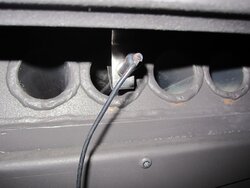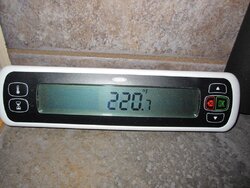I re-set my slide damper with two Magnehelic meters ( one digital, one analog). Ran stove on setting 5 for an hour and then adjusted slide damper. After re-adjusting and waiting for fire to level out I had the best flame and temperature with the mag. reading at .19. I could run the stove with the mag in the .15-.17 range but the flame was dark orange, black tips and lazy, also the temperature was a lot lower. I ran the stove back on my normal settings with the thermostat overnight and yesterday and now it appears that the flame is back to where it was before I re-set my slide damper. The damper is now set a little more than halfway in.
Here are my readings for my test:
Pellets: Spruce Pointe
Mag reading on high: .19
Temp of back plate: 731 degrees
I check my temps with an infrared thermometer.
Mag reading on setting 3: .18
Mag reading on setting 1: .16-.17
Today my mag. reading on setting 3: .24
How can this change overnight?
Before I did my re-set I totally cleaned the stove ( burnpot, ashpan, stovepipe, top plate, back plate, cleanout Tee), to try and get a good reading. I don't think that the stove can be that dirty in less than 24 hours.
Yesterday when I was checking the stove temps on setting 3 my backplate was at 400-410 degrees after 15 minutes of burn time. Today I can only reach around 360 degrees after 30+ minutes of burning on setting 3.
Do these stoves have a demo program or something in them? This is the third time I have done my slide damper set-up with the same results.
The dealer that set up the stove the first time is no longer in business and I haven't been able to reach anyone at Enviro.
Any info would be a great help.
Thanks,
Jon
Here are my readings for my test:
Pellets: Spruce Pointe
Mag reading on high: .19
Temp of back plate: 731 degrees
I check my temps with an infrared thermometer.
Mag reading on setting 3: .18
Mag reading on setting 1: .16-.17
Today my mag. reading on setting 3: .24
How can this change overnight?
Before I did my re-set I totally cleaned the stove ( burnpot, ashpan, stovepipe, top plate, back plate, cleanout Tee), to try and get a good reading. I don't think that the stove can be that dirty in less than 24 hours.
Yesterday when I was checking the stove temps on setting 3 my backplate was at 400-410 degrees after 15 minutes of burn time. Today I can only reach around 360 degrees after 30+ minutes of burning on setting 3.
Do these stoves have a demo program or something in them? This is the third time I have done my slide damper set-up with the same results.
The dealer that set up the stove the first time is no longer in business and I haven't been able to reach anyone at Enviro.
Any info would be a great help.
Thanks,
Jon



